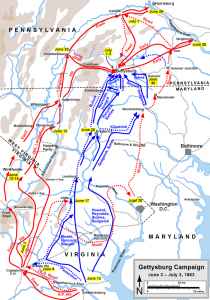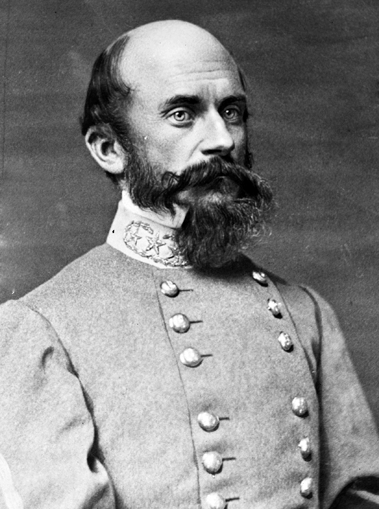“The Heat Is Frightful”: Two Lieutenants & The Gettysburg Campaign, Part 2

The Gettysburg Campaign progressed through the second week of June 1863. However, while some regiments marched long miles and battled or skirmished, others waited or moved miles behind the advance forces. The Civil War journals of Lieutenants Dooley and Rhodes include only one entry each for this week; the 1st Virginia had continued marching, but the 2nd Rhode Island stayed in the Fredericksburg area with the majority of General Hooker’s forces.
In this post, you’ll find those journal excerpts from Lieutenant John Dooley of the 1st Virginia and Lieutenant Elisha Hunt Rhodes and some campaign highlights to explain the happenings that these two officers did not know about.
June 10 – The lead elements of General Ewell’s Second Corps, Army of Northern Virginia, head for the Shenandoah Valley; they have orders to clear the Federals out of the Valley and would be followed by General Longstreet’s First Corps and General Hill’s Third Corps using separate, parallel routes into the Valley.
June 11 – Confederates continue their march; Union army continues to wait.

June 12 – As Rebels enter the Shenandoah Valley at Chester Gap, Ewell consults with his commanders to create a maneuver that will force the Union forces out of the northern part of the Shenandoah and intercept/capture as many as possible. Meanwhile, General Hooker thinks the Confederates are still somewhere between Culpeper and Fredericksburg and plots a new attack on Richmond; Lincoln discourages him, saying, “Lee’s army, not Richmond, is your true objective.”
June 13 – Union General Milroy who had his headquarters at Winchester is endanger of being surrounded by the fast moving Confederate Second Corps whose infantry swarms into the area and discovers a hill that dominates the three Union-held forts.
June 14 – Ewell launches a diversionary attack, followed by artillery fire on the Union forts from the dominate position at Winchester. Milroy starts to retreat, finding that other Confederate units have outmarched him, closing off his northward escape. The Army of the Potomac begins moving north toward Manassas Junction.
June 15 – The final day of the Second Battle of Winchester ends with the Confederates sealing off the escape routes and capturing the majority of Milroy’s nearly 7,000 troops. With the crossroads city in the lower Valley securely in Confederate hands, the Second Corps pushes ahead toward other Yankee-held towns and outposts
June 16 – Elements of the Army of the Potomac reach Manassas Junction. General Hooker dispatches cavalry to try to break through the Confederate cavalry screen which had effectively sheltered and covered the Army of Northern Virginia’s movements up to this time.
John Dooley, 1st Virginia Infantry
June 15th.
Resume our march, passing through Culpeper C.H. The heat is frightful, and the road in many places is strewn with the sunstruck. I stand the sun better than some of the stoutest of my men; and perceiving one of my poor fellows in great distress on account of his gun and accoutrements, I give him my sword for his rifle and it helps him along very much.
(Dooley’s journal only contains this entry, and he did not give a dated entry again until June 24th.)
Elisha Hunt Rhodes, 2nd Rhode Island Infantry
Mansfield, VA, near A.N. Bernard’s House, June 11/63
Tuesday night just before dark the Rebels shelled our camp on the north side of the river. They did not do much damage except to a hill in our rear which was well ploughed with shot. Our Batteries soon got the range of the Rebel guns and compelled them to stop firing and seek cover. The wife of the Surgeon of the 10th Mass. [Massachusetts] is on a visit to her husband. She was sitting in a tent on a hill on the north side when a solid 30lb. shot struck very near her. A shell burst in the air and a piece went whizzing through one of the tents. She went calmly to another hill and waited until the firing ceased, when she resumed her seat in her own tent again. Last night at 6 o’clock our Brigade crossed to the south side of the river, and for the third time we are near Fredericksburg. Our Regiment was immediately sent upon picket duty, way off to the left of our lines, and here we remained until morning without sleep. We arranged with the Rebels that neither side should fire unless an advance was made. On our right the firing was continuous through the night. We have just been relieved from picket duty and are resting inside of our works. The works are long and reach in a semicircle from river to river. I am well and happy.
To be continued next week…
Sources:
Rhodes, Elisha H. edited by Robert H. Rhodes. All For the Union: The Civil War Diary and Letters of Elisha Hunt Rhodes. Orion Books, NY: 1985.
Dooley, John. edited by Joseph T. Durkin. John Dooley, Confederate Soldier: His War Journal. University of Notre Dame Press, IN: 1963.